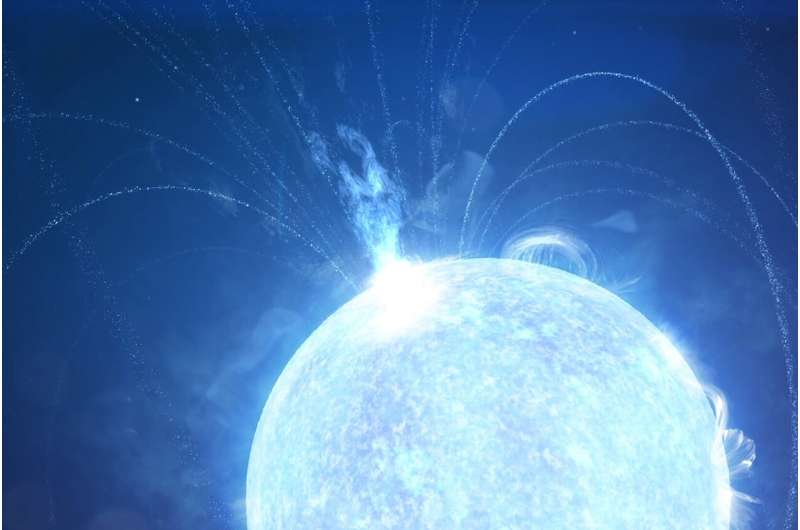This article has been reviewed according to Science X's editorial process and policies. Editors have highlighted the following attributes while ensuring the content's credibility:
fact-checked
peer-reviewed publication
trusted source
proofread
Volcano-like rupture could have caused magnetar slowdown

On Oct. 5, 2020, the rapidly rotating corpse of a long-dead star about 30,000 light years from Earth changed speeds. In a cosmic instant, its spinning slowed. And a few days later, it abruptly started emitting radio waves.
Thanks to timely measurements from specialized orbiting telescopes, Rice University astrophysicist Matthew Baring and colleagues were able to test a new theory about a possible cause for the rare slowdown, or "anti-glitch," of SGR 1935+2154, a highly magnetic type of neutron star known as a magnetar.
In a study published this month in Nature Astronomy, Baring and co-authors used X-ray data from the European Space Agency's X-ray Multi-Mirror Mission (XMM-Newton) and NASA's Neutron Star Interior Composition Explorer (NICER) to analyze the magnetar's rotation. They showed the sudden slowdown could have been caused by a volcano-like rupture on the surface of the star that spewed a "wind" of massive particles into space. The research identified how such a wind could alter the star's magnetic fields, seeding conditions that would be likely to switch on the radio emissions that were subsequently measured by China's Five-hundred-meter Aperture Spherical Telescope (FAST).
"People have speculated that neutron stars could have the equivalent of volcanoes on their surface," said Baring, a professor of physics and astronomy. "Our findings suggest that could be the case and that on this occasion, the rupture was most likely at or near the star's magnetic pole."
SGR 1935+2154 and other magnetars are a type of neutron star, the compact remains of a dead star that collapsed under intense gravity. About a dozen miles wide and as dense as the nucleus of an atom, magnetars rotate once every few seconds and feature the most intense magnetic fields in the universe.
Magnetars emit intense radiation, including X-rays and occasional radio waves and gamma rays. Astronomers can decipher much about the unusual stars from those emissions. By counting pulses of X-rays, for example, physicists can calculate a magnetar's rotational period, or the amount of time it takes to make one complete rotation, as the Earth does in one day. The rotational periods of magnetars typically change slowly, taking tens of thousands of years to slow by a single rotation per second.
Glitches are abrupt increases in rotational speed that are most often caused by sudden shifts deep within the star, Baring said.
"In most glitches, the pulsation period gets shorter, meaning the star spins a bit faster than it had been," he said. "The textbook explanation is that over time, the outer, magnetized layers of the star slow down, but the inner, non-magnetized core does not. This leads to a buildup of stress at the boundary between these two regions, and a glitch signals a sudden transfer of rotational energy from the faster spinning core to the slower spinning crust."
Abrupt rotational slowdowns of magnetars are very rare. Astronomers have only recorded three of the "anti-glitches," including the October 2020 event.
While glitches can be routinely explained by changes inside the star, anti-glitches likely cannot. Baring's theory is based on the assumption that they are caused by changes on the surface of the star and in the space around it. In the new paper, he and his co-authors constructed a volcano-driven wind model to explain the measured results from the October 2020 anti-glitch.
Baring said the model uses only standard physics, specifically changes in angular momentum and conservation of energy, to account for the rotational slowdown.
"A strong, massive particle wind emanating from the star for a few hours could establish the conditions for the drop in rotational period," he said. "Our calculations showed such a wind would also have the power to change the geometry of the magnetic field outside the neutron star."
The rupture could be a volcano-like formation, because "the general properties of the X-ray pulsation likely require the wind to be launched from a localized region on the surface," he said.
"What makes the October 2020 event unique is that there was a fast radio burst from the magnetar just a few days after the anti-glitch, as well as a switch-on of pulsed, ephemeral radio emission shortly thereafter," he said. "We've seen only a handful of transient pulsed radio magnetars, and this is the first time we've seen a radio switch-on of a magnetar almost contemporaneous with an anti-glitch."
Baring argued this timing coincidence suggests the anti-glitch and radio emissions were caused by the same event, and he's hopeful that additional studies of the volcanism model will provide more answers.
"The wind interpretation provides a path to understanding why the radio emission switches on," he said. "It provides new insight we have not had before."
More information: G. Younes et al, Magnetar spin-down glitch clearing the way for FRB-like bursts and a pulsed radio episode, Nature Astronomy (2023). DOI: 10.1038/s41550-022-01865-y
Journal information: Nature Astronomy
Provided by Rice University



















